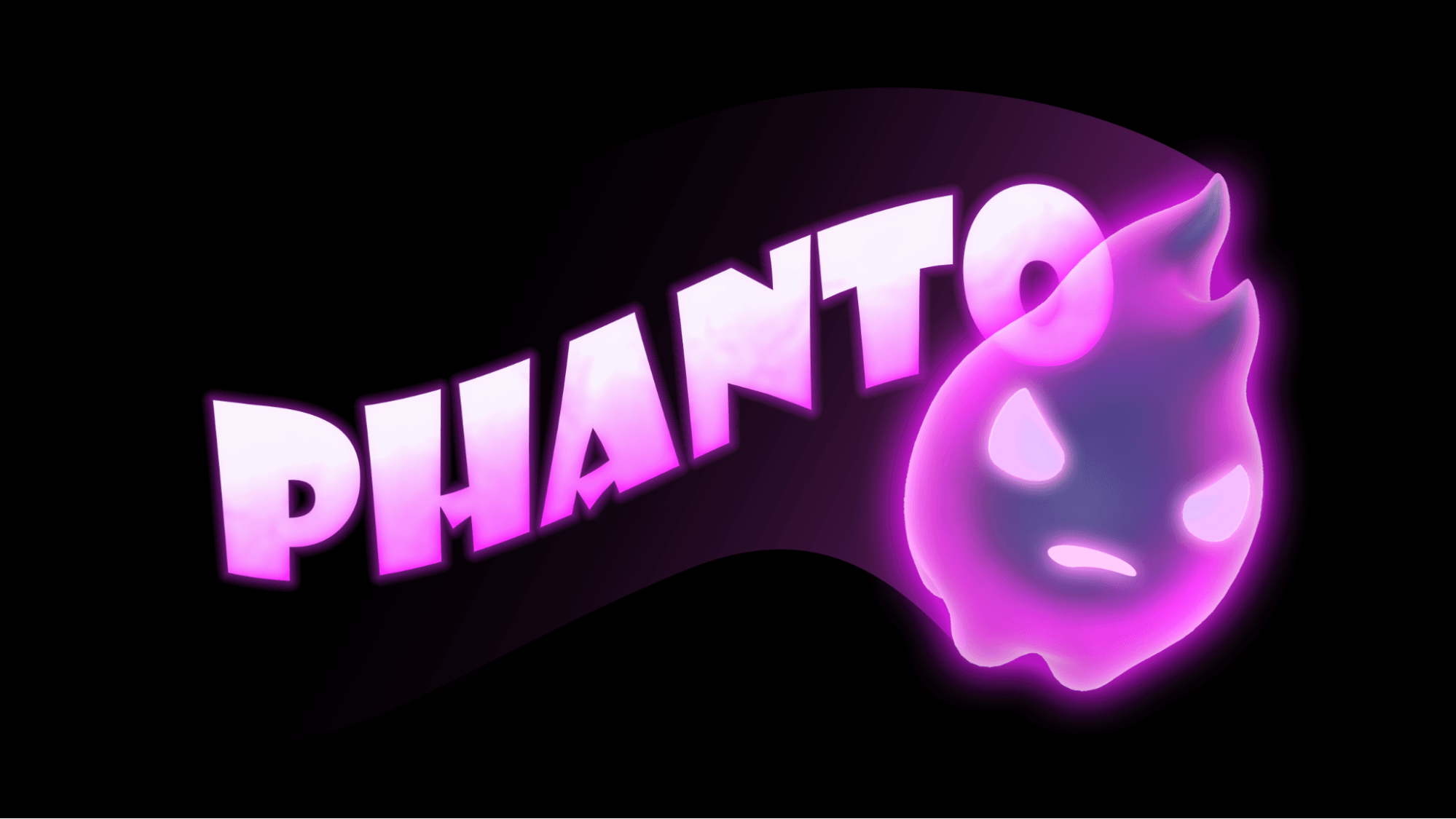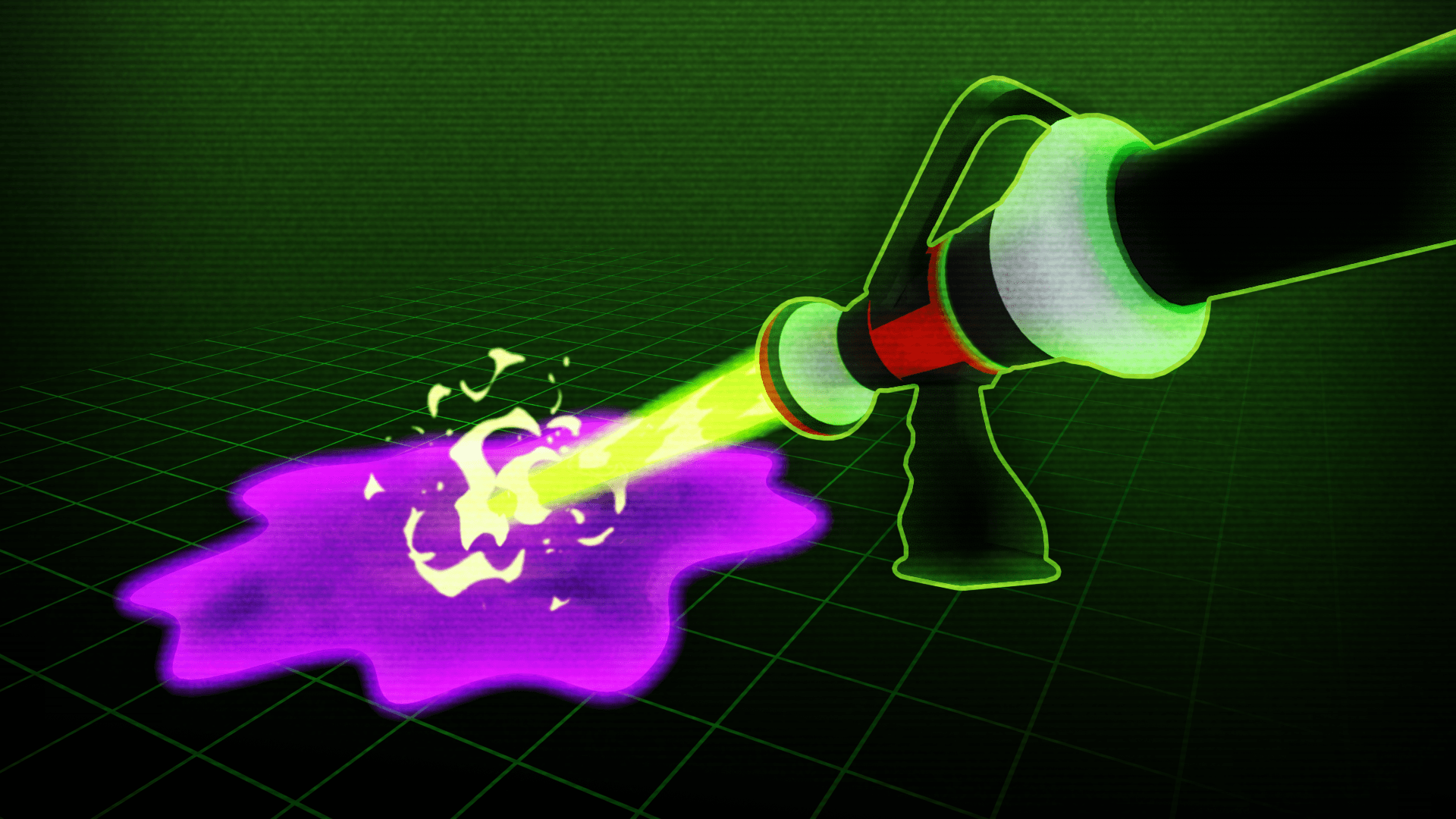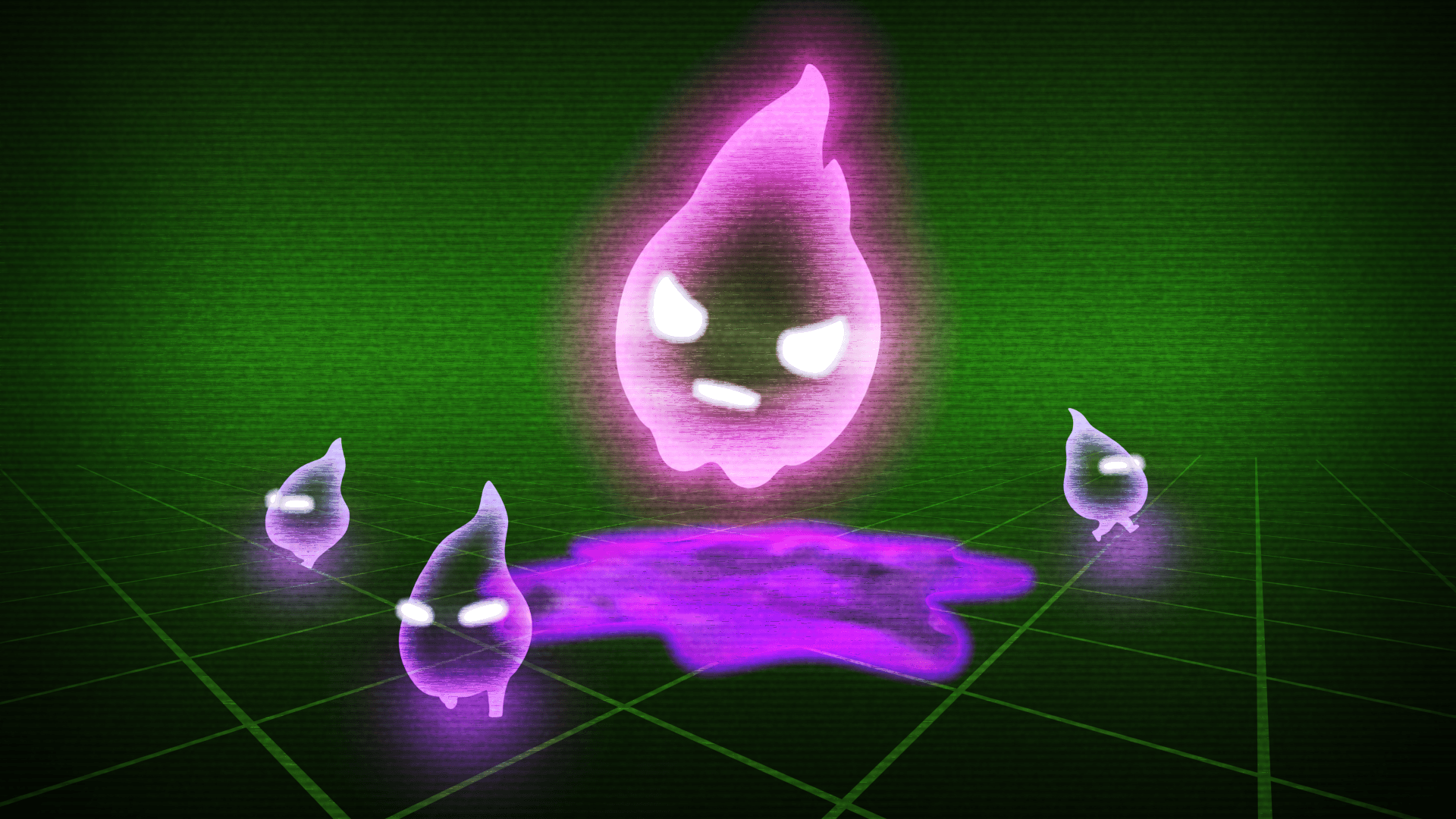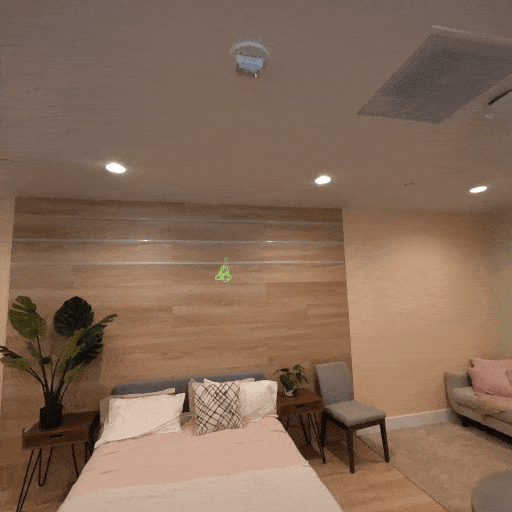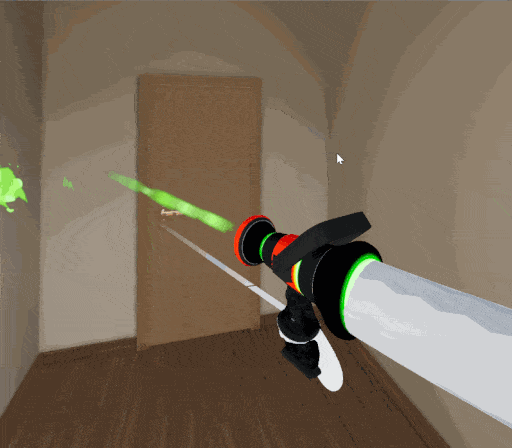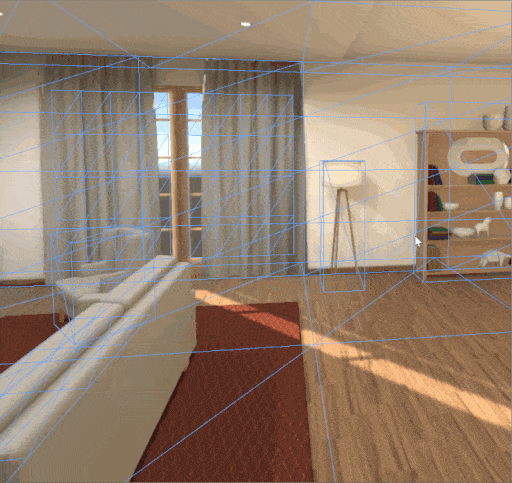Project Phanto is an Unreal reference app, showcasing the latest Presence Platform features, highlighting scene mesh, Scene Model, and Scene API objects. It was developed using the Meta fork of Unreal Engine 5.3.
The scene mesh is a low-fidelity, high-coverage artifact which describes the boundary between free and occupied space in a room. It is generated automatically during the Space Setup experience, and available for applications to query via Scene API.
The haptic assets used in this project have been designed with Haptics Studio, and were integrated using the Haptics SDK for Unreal following our Haptic Design Guidelines.
This codebase is available as both a reference and a template for mixed reality projects. The Oculus SDK License applies to the SDK and supporting material. The MIT License applies to only certain, clearly marked documents. If an individual file does not indicate which license it is subject to, then the Oculus License applies.
See the CONTRIBUTING file for how to help out.
First, ensure you have Git LFS installed by running this command:
git lfs installThen, clone this repo using the "Code" button above, or this command:
git clone https://github.com/oculus-samples/Unreal-PhantoEpic Games Launcher with MetaXR plugin
The easiest way to get started is to use the prebuilt Unreal Engine from the Epic Games Launcher, with MetaXR plugin.
- Install the Epic Games Launcher
- In the launcher, install UE5 (recommended).
- Download and install the MetaXR plugin from the Unreal Engine 5 Integration download page.
- Launch the Unreal Editor
- From "Recent Projects", click "Browse" and select
Phanto.uproject
Meta fork of Epic’s Unreal Engine
The Meta fork of Epic’s Unreal Engine will give you the most up to date integration of Oculus features. However, you must build the editor from its source.
-
Follow the instructions on Accessing Unreal Engine source code on GitHub to obtain:
- an Epic account
- a GitHub account
- authorization to access the Unreal Engine source repository
Disregard instructions on downloading Epic’s Unreal Engine source code as you will be building the Meta fork of Epic’s Unreal Engine source.
-
Make sure you have Visual Studio installed properly:
- Launch the Visual Studio Installer and click Modify for the Visual Studio version you want to use.
- Under the Workloads tab, click Game development with C++ if it isn’t checked and then click Modify.
-
Download the source code from the Meta fork of Epic’s Unreal Engine on GitHub.
-
Follow Epic’s instructions on Building Unreal Engine from Source to complete the process. Depending on your machine, the build may take awhile to complete.
-
Open a command prompt in the root of the Unreal repo, then run this command:
.\GenerateProjectFiles.bat -Game Phanto -Engine <full path to Unreal-Phanto directory>\Phanto.uproject
There are three options for running the project.
Running on a Quest 3
Build, deploy, and run the game on your headset.
Running with Quest Link
- Open the Oculus app.
- Run Oculus Link from the headset.
- Run the game in Unreal using the VR Preview button.
*NOTE: Scene mesh and room elements will show up in Link. However, you can only trigger room scan from within the headset. Please do it beforehand.*
Running with XR Simulator
- Enable XR Simulator, and press Play.
- Run the game in Unreal using the VR Preview button.
After opening the project, you will find three main scenes and nine example scenes:
- LobbyScene.umap: this self-contained scene contains the introduction scene, showing the current mesh, and allows the player to start the game.
- TutorialScene.umap: contains the tutorial for the player, presenting the controls and game dynamics.
- GameScene.umap: this self-contained scene contains the assets for the actual gameplay. This includes Phanto, the Phantoms, and other assets.
When building mixed reality experiences, we highly recommend evaluating your content from a health and safety perspective to offer your users a comfortable and safe experience. Please read the Mixed Reality H&S Guidelines before designing and developing your app using this sample project, or any of our Presence Platform features.
Developers should avoid improper occlusion, which occurs when virtual content does not respect the physicality of the user’s environment. Improper Occlusion can result in a misperception of actionable space.
-
To avoid improper occlusion, developers should ensure that users have (1) completed Space Setup and (2) granted Spatial Data permission (setup design) to allow proper occlusion in content placement, mesh collisions, and air navigation.
Using semi-transparent content lets the user have a better view of their physical space and reduces the occlusion of objects or people that are not part of the scanned mesh.
-
Spatial data won’t incorporate dynamic elements of a user’s living space (for example, a chair that was moved after capture or a moving person/pet in the space).
-
Uncaptured dynamic elements may be occluded by virtual content, making it more difficult for a user to safely avoid such hazards while engaged in the mixed reality experience.
The following diagrams represent the game's main user flow.
Prior to starting the game, the setup flow will verify the user has:
- Completed Space Setup and has a Scene Model
- Granted Spatial Data permission (implementation instructions)
Without these two requirements, the application can't function. Therefore, the user will only be able to advance to the next scene after complying with these requirements.
graph TD;
Lobby-->SpaceSetup;
SpaceSetup-->Lobby;
Lobby-->Permission;
Permission-->Lobby;
When permission is denied, or if no Scene Model is present, the user will be presented with prompts that allow them to rescan their room and grant permissions.
| Missing scene prompt | Permission prompt |
|---|---|
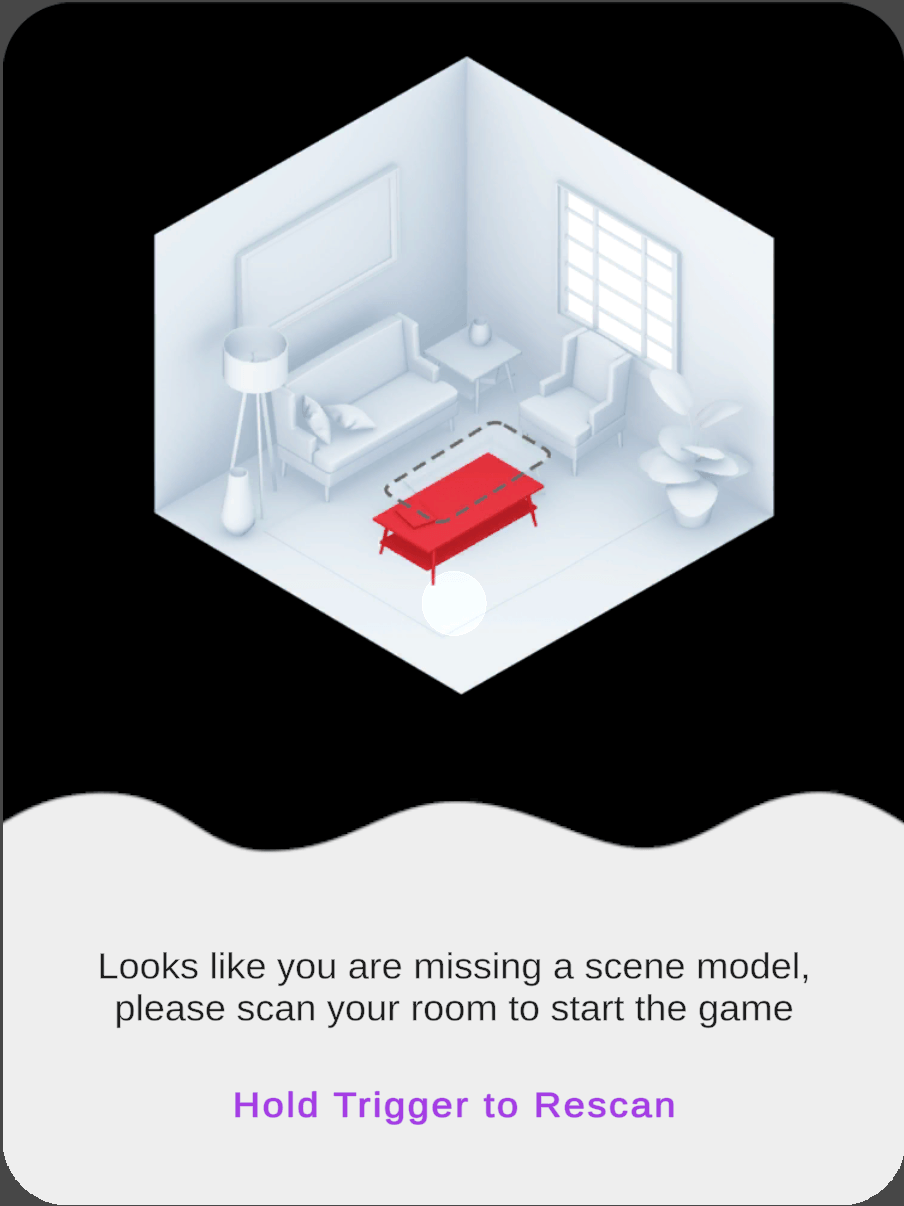 |
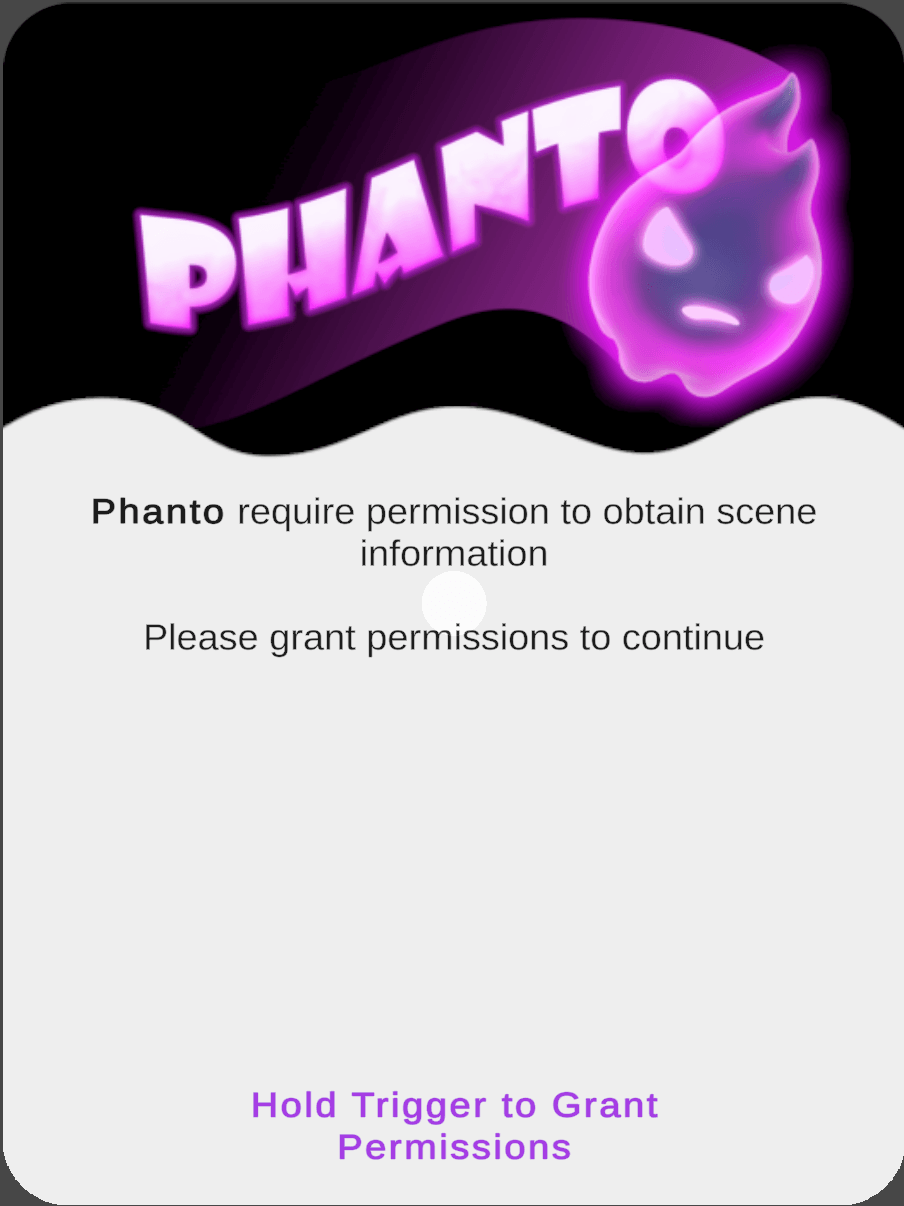 |
The following diagram shows the high-level states for the player after they have fulfilled the requirements above. When launching the game for the first time, the player will go through a tutorial. Afterward, the tutorial can be skipped.
graph TD;
Lobby-->Tutorial;
Lobby-->Game;
Tutorial-->Game;
Game-->Win;
Game-->Lose;
Win-->Game;
Lose-->Game;
| Device | Scene API | Color Passthrough | High res color | Scene Mesh | Haptics1 |
|---|---|---|---|---|---|
| Quest 3 | ✔️ | ✔️ | ✔️ | ✔️ | ✔️ |
| Quest Pro | ✔️ | ✔️ | ❌ | ❌ | ✔️ |
| Quest 2 | ✔️ | ❌ | ❌ | ❌ | ✔️ |
1: There have been significant improvements in the haptics capability of Quest Pro and Quest 3 controllers over Quest 2: Quest Pro and Quest 3 introduce TruTouch haptics, enabling a new level of immersion in your applications. For more information, visit our Haptic Design Guidelines.
The game demonstrates our recommended best practices when using the new scene mesh feature and updated Scene API.
The scene mesh is provided in the project and is accessed using PhantoSceneActor. Each one of the maps will create a PhantoSceneActor and automatically load the mesh and room elements captured during the space setup flow. The scene mesh will be represented as a standard Unreal StaticMeshComponent and will respond to ray casts.
For more information on how to get started with scene mesh, visit Meta Quest Developer Portal.
The Ectofluid is a ghostly goo, created both by Phanto and their Phantoms. Beware: once your room gets too covered with goo, you lose the game.
This element demonstrates the ability to place virtual content onto the physical environment represented by the scene mesh. With this new ability, content can be attached anywhere within the room reconstruction, adjusting itself to the real physical environment.
This element demonstrates the use of the scene mesh as a physics component. This allows the fluid to collide with the mesh, and creates a splashing effect. We recommend using particles with fast collisions to create a more immersive experience.
- Use the Polterblast 3000 to throw Ectofluid and clean the ghostly goo from your room.
- Press the Right Trigger to throw Ectofluid
Watchout! Some Phantoms are appearing in your room. Use the Polterblast 3000 (RT) and the Ecto Blaster (LT) to defeat all of them.
- Phanto is an air-navigated NPC that uses the scene mesh as a sensor to figure out available places, both to navigate to, and to spawn virtual elements onto (Ectofluid).
- The Phantoms are small, ground-navigated NPCs that use both the scene mesh and the room capture data (chairs, couch, desk, windows, etc.) to navigate across the environment, jump to targeted places, and spawn content (Ectofluid).
The Ecto Blaster allows you to defeat the Phantoms. Place it in your room, and it will target and throw Ectofluid at them. To place the Ecto Blaster, point to any location in your room and press the Left Trigger. This element demonstrates the ability to trace and ray cast against the environment, using the scene mesh as a ray cast layer. This allows the user to create and place virtual content in mixed reality that responds to the scene.
This scene functions as an introductory scene for the player. The player can view their scene, scan it, and change it. If no scene information is provided, the player will be guided to the Space Setup flow. If there is scene information for the current environment, the player can advance to one of these three options:
- TutorialScene: starts the tutorial for the player.
- GameScene: starts the game for the player.
- Trigger Space Setup: using the left trigger, the player can restart the Space Setup process, allowing them to rescan the environment in case something has changed.
| Rescan Scene | Start Game |
|---|---|
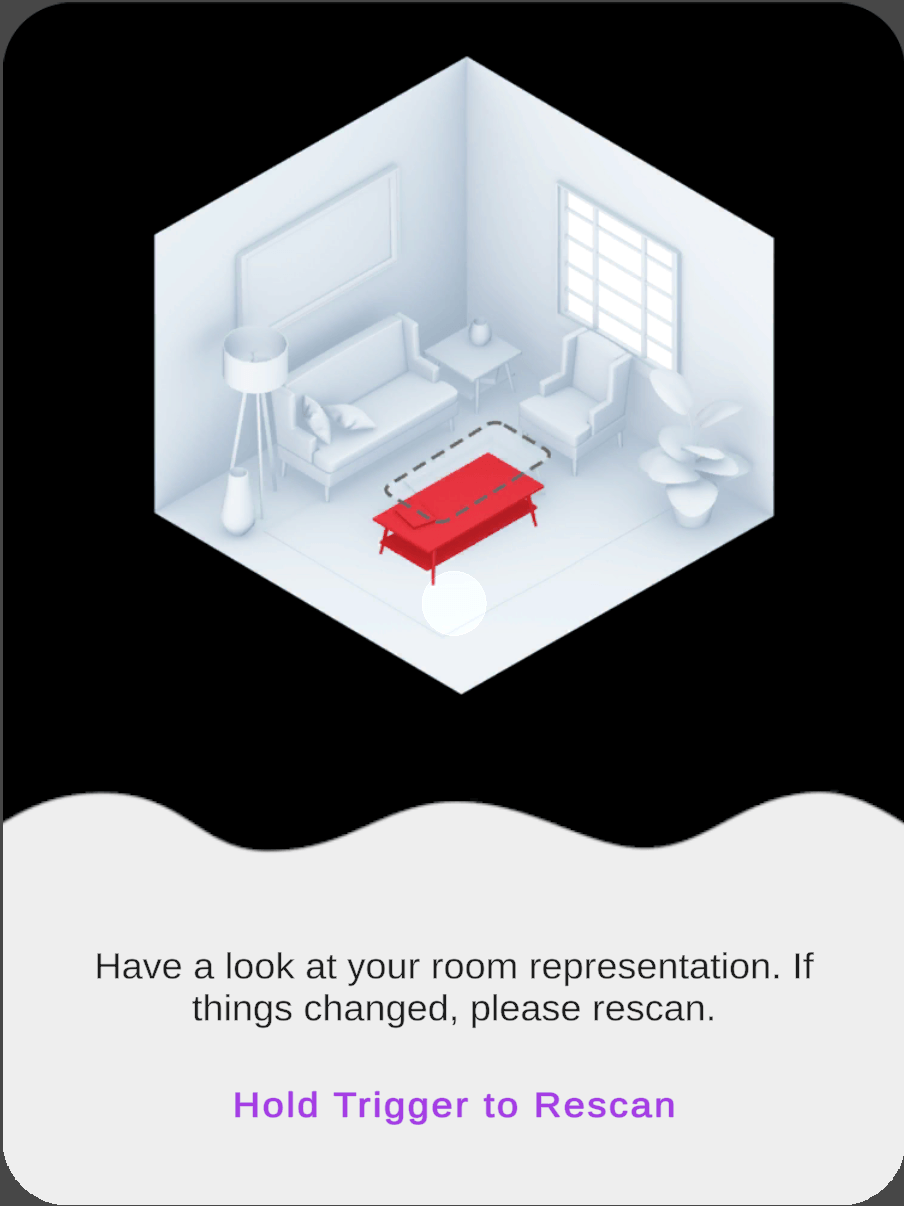 |
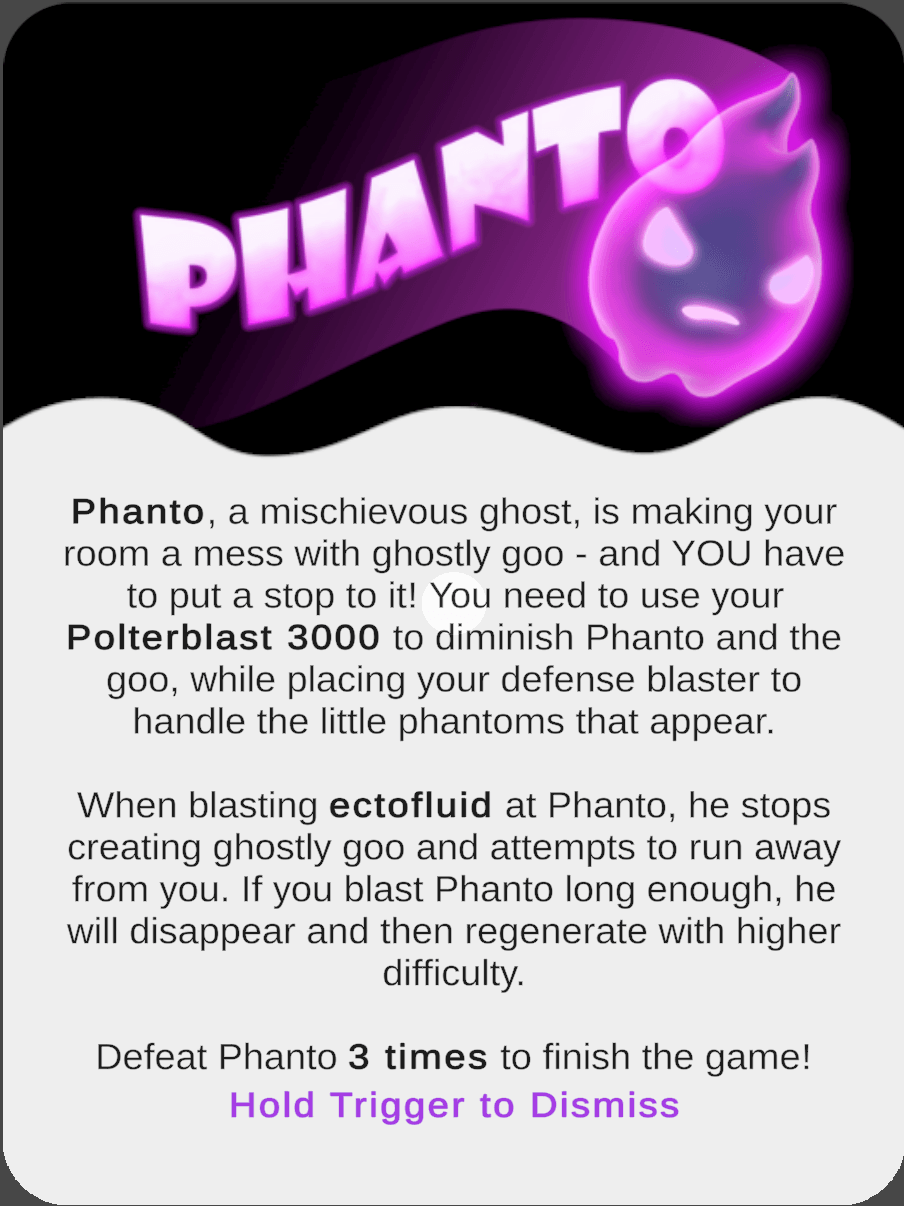 |
The tutorial scene introduces the player to game mechanics. In this scene, the player will learn how to:
- Use the Polterblast 3000.
- Place the Ecto Blaster.
- Shoot and interact with Phantoms.
When running the app for the first time, the tutorial is mandatory. Afterward, the player will have the option to repeat the tutorial, or jump right into the game.
In this scene, you can find examples of how some subcomponents (excluding Phanto) are used in the game. In addition, a set of controller-locked UI screens can be found here.
| Welcome | Polterblast | Ecto Blaster | Phantoms | Start Game |
|---|---|---|---|---|
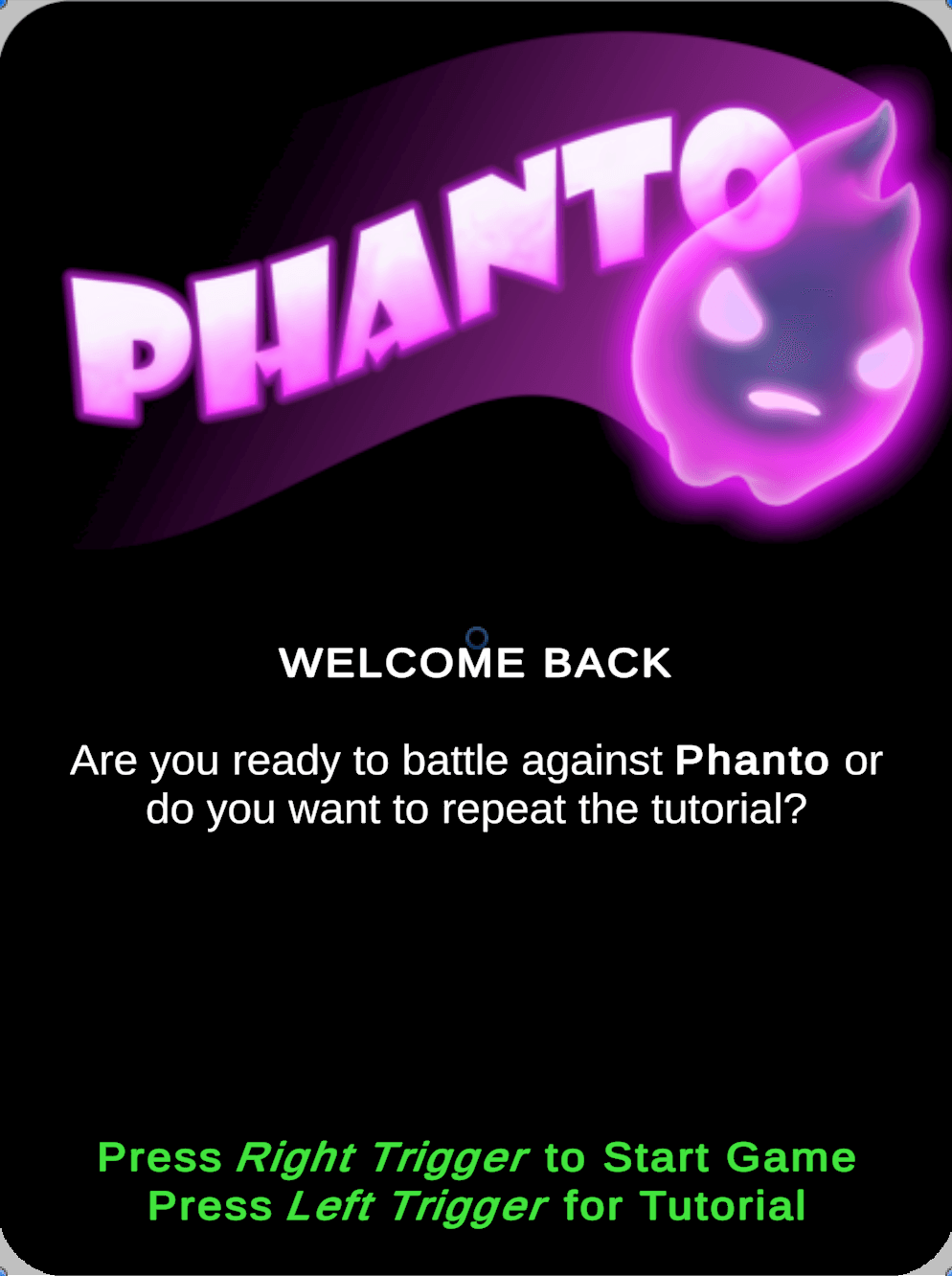 |
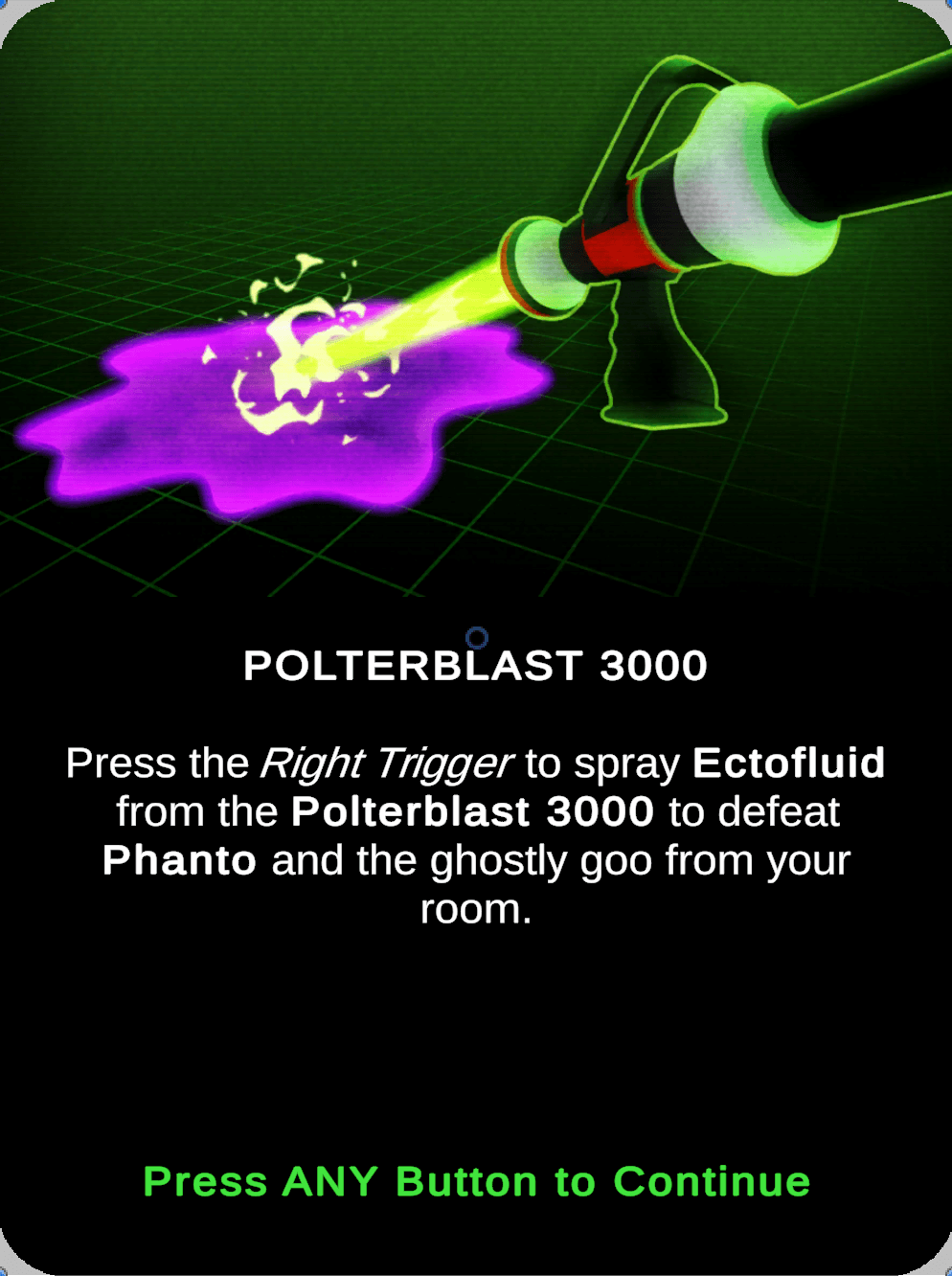 |
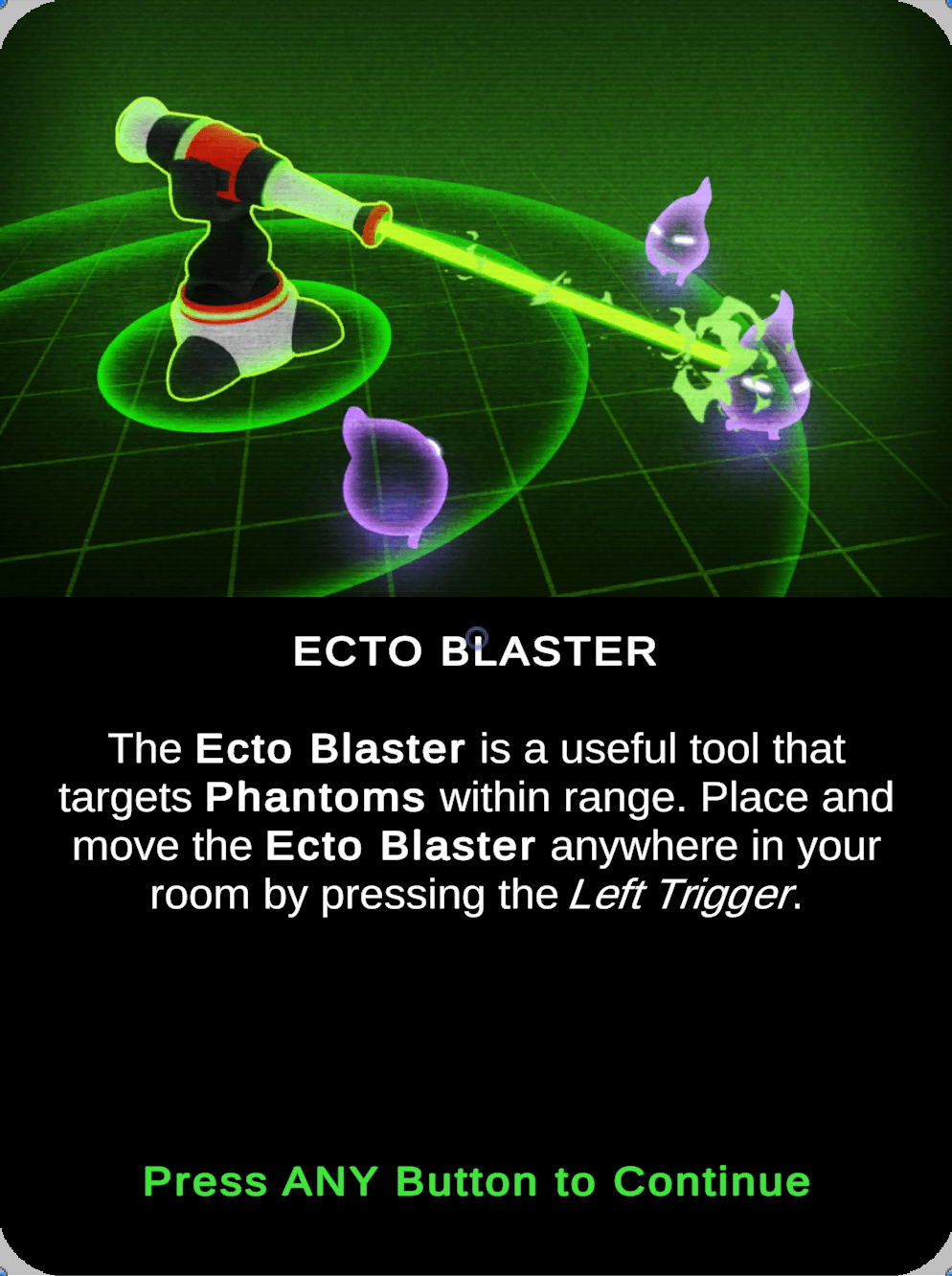 |
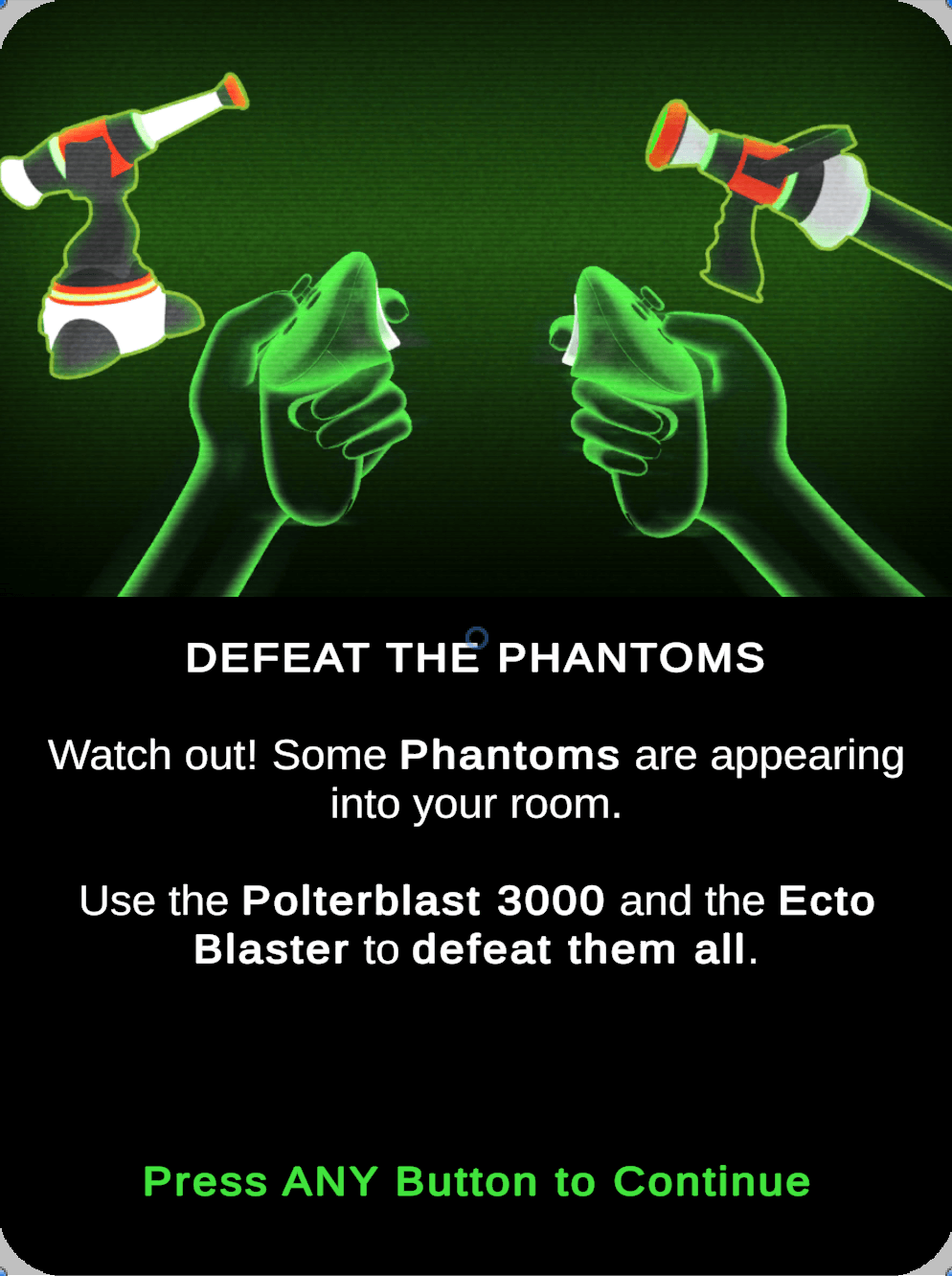 |
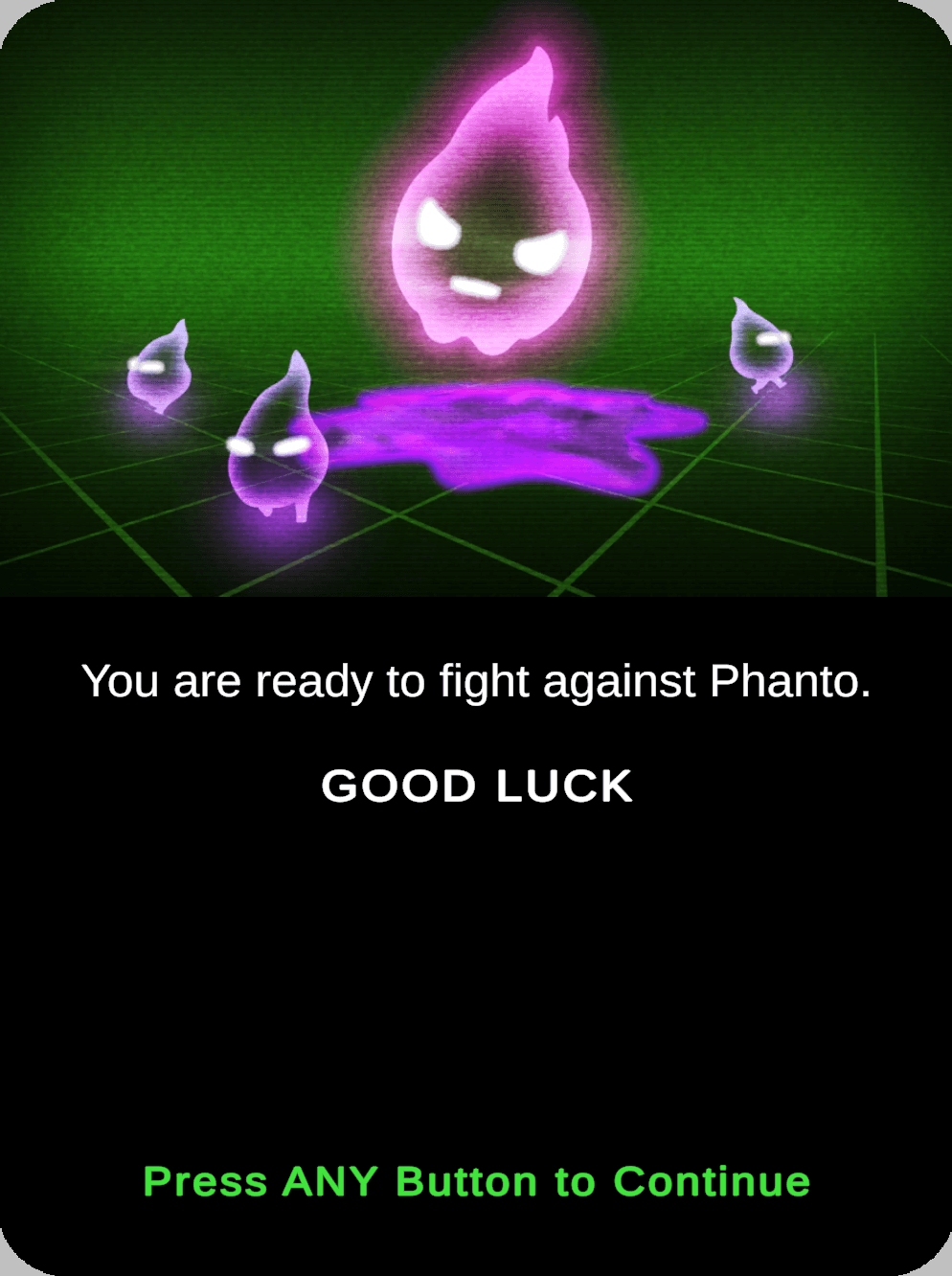 |
This scene includes prefabs for the main game components:
- Phanto
- Phantoms
- Polterblast 3000
- Ecto Blaster
You can use the scene in standalone mode and run it using Oculus Link, or by building and deploying it to your device.
All the game components are present in this scene, and restarting the game is as simple as reloading the scene. In addition, you can find debug features within the scene, that can be enabled using the Menu button on the left controller.
Within the scene, you can find the PhantoSceneActor component, which takes care of loading the mesh and scene information. Other components in the scene are used to manage sound, GUI alerts, runtime assets, and game events.
| Object Placement | AI Navigation |
|---|---|
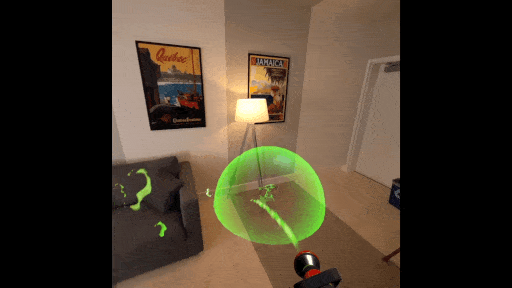 |
 |
Showcases the integration of haptics with dynamic modulation tied to controller interactions: Pressing the index or grab button will trigger a synchronized audio-haptic effect. Moving the thumbstick up or down will modulate the amplitude of the effect, while moving it left or right will modulate the frequency.
The haptic assets used in this project have been designed with Haptics Studio, and were integrated using the Haptics SDK for Unreal following our Haptic Design Guidelines.
To learn more about the Haptics SDK for Unreal, and how dynamically modulated haptics were implemented, check out the BP_VRExamplePawn blueprint in the Haptics Scene, or the Play random sound and haptic function in the BP_Phanto blueprint for the Phanto haptics featured in the main game loop!
The BP_EctoBlasterSpawner blueprint illustrates how to use the global mesh to place an object on the surfaces of the room.
The EctoStream particle system demonstrates using the global mesh for physics. Using fast collisions, the recommended way, the Ectofluid splashes off the mesh. It does this by using the Collision module in the Niagara particle system to bounce the particles off the surface of the global mesh.
BP_Phanto shows
how to use the scanned mesh as a sensor for an air navigated character (Phanto). See the OnSphereOverlap function in that blueprint for more info.
GameScene's Level Blueprint shows
how to use the mesh for ground navigation, with and without additional bounding
box information on the furniture (acquired using manual capture of the room
elements). You can see the NavMesh by running the console command show Navigation through the ~ terminal, or through adb when on on device.
The scene's NavMesh is dynamically generated using the settings in DefaultEngine.ini under [/Script/NavigationSystem.RecastNavMesh] and [/Script/NavigationSystem.NavigationSystemV1].
Note that bInitialBuildingLocked=True. This allows GameScene to wait until the scene anchors have been spawned before creating the NavMesh, which is done when it calls ReleaseInitialBuildingLock().
Once the NavMesh has been generated, GameScene also calls SetNavigationRuntimeGenerationMode(Static) and ConfigureNavigationSystemAsStatic(true).
All of these functions are available in PhantoBlueprintFunctionLibrary.h.
The LobbyScene presents the mesh and the furniture bounding box, if available.
